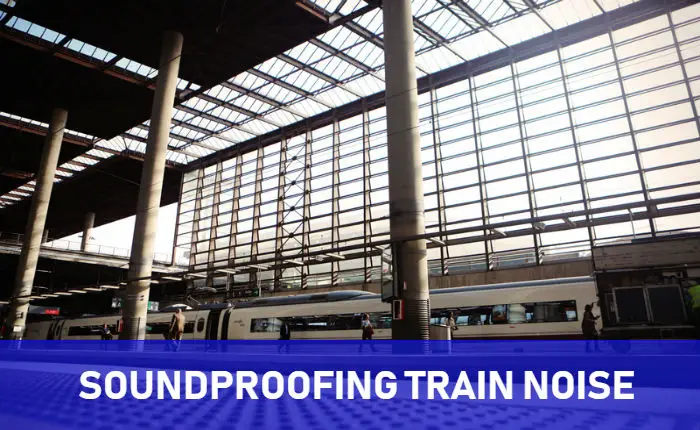Train noise and horns are the worst: the public enemy of peace and soundproofing. We will show you the right way to soundproof against train noises and horns. If train noise affects you, there are ways you can deal with it. It’s not worth compromising your sleep and peace of mind.
Imagine this. It is Sunday morning, and you’ve gotten over your hangover from partying last night. Your head still hurts a bit, but it is nothing too serious. It is warm and sunny outside, birds are chirping, you stretch and feel the like in heaven. Life is good, right until it comes without a warning. By your house passes a huge lump of steel with wheels, carrying whatever. You pray it will pass quickly, but fate is not so forgiving.
Without warning, it bellows a primal scream that echoes through your head like a mighty chorus of a thousand vuvuzelas. The sound is so powerful and sudden that it immediately burrows through your eardrums and drills into your skull. Your morning is now ruined. Thomas the Tank Engine has come to town.
Don’t you hate it? Well, I do. I like trains, but I hate them for this particular reason aside often being late. And so do you. Then what should you do? No worries friend, I am here to share your lamentation and help you get yourself a good weekend sleeping session.
If you have read my previous articles, you already know that I have already written on the subject of sound-proofing. So what is the point of this article then? Isn’t it the same in the end? No, it isn’t. Try comparing a washing machine to a train and you will get one hell of a migraine. But fear not, for I am here to lend my wisdom to you once again.
Why all the ruckus?
Hate them as we might, but trains are necessary in the end. You would be surprised how many people are unable to spot a giant steel behemoth that rolls towards them in plain sight. Many have died due to this and, as such, most countries require trains to sport powerful horns for safety reasons.
And the faster the train, the longer the sound has to be.
How to stop the train noises right in their tracks? (pun intended)
There are two possibilities to address this issue. There are short-term solutions and long-term solutions.
Short term solutions
These are a bit counter-productive in nature, as they do lower the sound level for a bit, but will not do much in the long run. And, added to that, you will probably go insane from reinstalling them each and every time they fall apart.
Sticking towels/rags underneath the door
The cheapest kind of door sweeps. The fun thing with them is that you won’t have to drill through the door to install them. Just stick them down there and voila. Their disadvantages, compared to the proper door sweeps, are that they will do a poor job in sound-proofing. Plus, you will have to re-adjust them whenever you open or close the door which will promptly make you insane. And, because they are not as dense as proper door sweeps, the sound will still get through them to a significant degree. All in all, buy yourself proper rubber or foam sweeps. They are under $10 and will last you for a very long time.
High-quality carpets
A simple solution would be to get some good quality, thick rugs. Due to how physics works, namely the vibrational nature of sound, even your floors can conduct some of the incoming sounds. The solution is to invest in some thick carpets that will absorb the vibrations passing through the floors.
In the end, however, despite being cheap, short-term solutions will only minimize the incoming train noises. In order to properly stop them from being annoying, you have to invest in some long-term train noise reduction options. And don’t worry, because those solutions, albeit costly, will not only stop train noises but all noises. So rest assured that you are investing in the general future of your household.
Long-term solutions
Door sweeps
This is an old tried and true sound-proofing method. They are cheap, easy to install, and highly reliable in what they do. Even the newest house doors out there can’t be 100% soundproof; they will still have that small gap underneath for movement and for air to flow. Otherwise, they would be sold as walls.
Proper door sweeps are made from DIY soundproof materials. This means that they do their job to a high standard. Due to their flexibility, once you have closed the door, they will automatically fill any gap down there. This means that any sound that will pass through is more likely to enter through the doorknob or the door itself.
Plus, they are really easy to install. All you need is a door, the purchased kit (which comes with everything you need) and some basic tools. They always come with instructions, so nobody will risk accidentally burning the house while screwing a few bolts.
Soundproof industrial curtains
This is another ”fan favorite” and for good reasons. Not only are they relatively cheap as a long-term investment, but they do wonders in combating train noises. You see, soundproof curtains are able to create a loss of 35 decibels at high frequencies, making them an ideal defense against train horns.
This is because they support very heavy layer of material sandwiched between the sound absorption layers. For example, an industrial sound curtain will be made from two panels of quilted fiberglass with a layer of mass-loaded vinyl. Depending on the materials used and the thickness, it can weight from 0.5 to 2.5 lbs per square foot (1 to 6 kg/m2). It is this mass that grants it its sound-stopping power.
Install sound-blocking window panels
Other than the doors and the walls, the quality of the windows is a crucial factor in sound-proofing. Just like a certain operating system asking for constant updates, train noises don’t give a damn about your well-being.
An effective way to tackle this problem (for non-industrial purposes) is to install flexible window panels made from a heavy sound-blocking material.
Double-glazed windows are a commonly used method of sound-proofing your home, albeit a bit costly. Their double-layered design will stop any vibration that would otherwise sneak through the gaps into your home, making them a must-have. They last for a very long time and usually are worth their steep price.
Invest in gypsum walls
Depending on the design and the materials used in the construction of your house, already-existing walls can be made soundproof. This is achieved through a few distinct methods:
Infusion: commonly known as fiberglass insulation or cellulose insulation. It is where the walls are filled with soundproofing foam through specialized hoses, pumps, and machines through holes drilled into the wall. This method is the cheapest of the three and highly recommended for homes where the walls are hollow and easily replaceable. Furthermore, the materials used dry out very quickly, making them a god-send for places with high levels of humidity. This method also is environmentally safe an non-toxic, making it family friendly.
Drywall: most common of them all. I have already touched it in my previous article regarding soundproofing. It is simply a secondary layer of drywall or gypsum wall plastered to the existing wall, thickening it. This is done with an added layer of ”Green Glue” damping compound between the two to strengthen the process. Green glue is a material used as a constrained membrane that converts sound energy into heat.
Paint: for the artist within, there is the solution of soundproof paint. This specially-formulated acoustical paint is a complex compound that can simply be added to your walls. Its effectiveness has been reported to be so great as to reduce outside noises up to 30%. It is made from sound-absorbing resins, fillers, and hollow ceramic microspheres which sound as cool as they are effective.
To apply it, you only need to use a paint roller for the larger areas and angled paintbrushes for the harder-to-reach corners and edges. Acoustical paint dries extremely quickly and possesses superior sound-dampening qualities. For optimal results, you should apply not one, but two coats of paint.
Creating outdoor barriers
It’s always the small things that come to help you in life. And soundproofing the interior of the house will not always bring the full, desired outcome. And boy oh boy, you can add up the benefits through previously unthinkable methods.
First of them is raising a fence. Seems stupid right? Because it isn’t. If you have studied physics before, you know how sound works. It is basically vibrations, coming from a vibrating body, through a vibrating medium (air, water), traveling in longitudinal waves. The clue that sits in all of this mumbo-jumbo: it travels. So, if you plaster a fence or a wall in the general direction of the train tracks, some waves will be stopped mid-track. The consequences are minute, but a good chunk of sound will stop before reaching your house. And you need to have a fence, right?
Another fine addition, if you live in a house with a yard, would be to plant bushes, shrubs, and trees. Choose greenery with a dense growth of plants. Those types are the best in urban areas, as they will not only protect you from train noises but from any noise. They don’t offer the soundproofing qualities of a concrete bunker, but they work together with the others to improve life quality. Plant them so that there is not much space between them when they reach maturity.
The best shrubs for soundproofing purposes are Evergreen shrubs. Not only do they look fancy, but they will provide year-long noise reduction. Always choose shrubs and trees with dense branches and leaves.
Keep in mind that you are not just blocking sounds with your lovely garden of green walls; you also are reducing pollution, creating a more aesthetic atmosphere, and reducing pollution. Form and function, all in one.
Highways panels?

Soundproofing panels for highway
You probably saw these on some highways that were near a residential area. They are there to “block” or dampen a bit of the loud noise made by high-speed cars. You probably can’t afford these, but you raise a ticket to the local municipality to install this type of panels in areas where the train noise is not supportable. You never know, you can get lucky and maybe they will do something about it. If you can convince your neighbors to sign a petition, that would be great too.
Conclusion
It is estimated that in order to properly soundproof a room, one must expend somewhere from $500 and up to $4,500. Nobody said that this would be a cheap endeavor. Still, you should expect a price range of $1,000$ to $2000.
Add in the cost of everything you do around the house, and you will quickly notice that this is something to be done as a long-term investment. Do it only if you plan to not move away any time soon.
Try these methods first if the noise is not that bad. But if you can’t sleep well, don’t just stand there, do something about it. Compromising your night sleep is not the right way.
